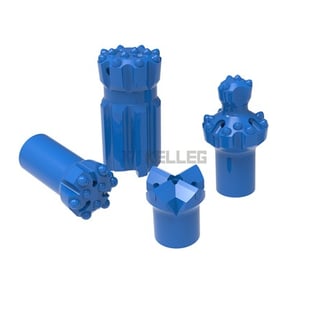Join us in advancing geotechnical engineering. Email: una@kellegco.com

What Size Rock Drill Bits Do We Actually Need?
Rock drill bits include top hammer rock drill bits, down-the-hole drill bits, roller drill bits, PDC drill bits, etc. Different models of drill bits are suitable for different rock hardness and operating environments.
Una
7/10/2024


Rock drill bits are indispensable tools in mining, tunnel construction, and foundation engineering. With their powerful crushing ability and high operating efficiency, they play a crucial role in advancing project progress and ensuring project quality. However, in the face of complex and changeable rock types and engineering requirements, how should we choose the size that suits our needs?
Understanding the types of rock drill bits
Generally, rock drill bits include top hammer rock drill bits, down-the-hole drill bits, roller drill bits, PDC drill bits, etc. Different models of drill bits are suitable for different rock hardness and operating environments. Therefore, before choosing the drill bit size, it is crucial to clarify your operating needs and rock characteristics.
Importance of rock drill bit size
The size of the rock drill bit is directly related to its crushing ability, drilling efficiency, and operating cost. If the size is too small, it may not be able to effectively crush hard rocks, resulting in slow progress and increased energy consumption; if the size is too large, it may cause problems such as equipment overload and increased risk of damage. Therefore, the correct selection of rock drill bit size is the key to ensuring the smooth progress of the project, reducing costs, and improving benefits.
Consider the relationship between rock characteristics and drill bit size
The hardness, toughness, and degree of joint development of rocks directly affect the selection of rock drill bits.
Soft rock, such as mudstone, or shale, can choose a relatively small drill bit for fast drilling. These rocks are relatively easy to break, and small-sized drill bits are sufficient to meet the needs while reducing energy consumption and wear.
Medium-hard rock, such as sandstone, and limestone, needs to choose a moderate drill bit size to balance the drilling speed and drill bit life. This type of rock is neither rigid nor loose, and a moderate drill bit size can reduce loss while ensuring efficiency.
Hard rock, such as granite, and basalt, must use large-sized, high-strength drill bits for operations. Hard rock has a higher impact and wear on the drill bit, and a large-sized drill bit can provide a stronger crushing force and better stability to ensure smooth operation.
Determine the drill bit size according to the operation requirements
Aperture requirements: first, clarify the size of the hole you need. The diameter of the rock drill bit directly determines the hole diameter of the drilled hole. When choosing a drill bit, you should choose a drill bit diameter that matches it according to the actual project requirements.
Drilling depth: it is also an essential consideration in selecting the size of the drill bit. For drilling deeper holes, we should choose a drill bit with a moderate length and stable structure to ensure the stability and safety of the drilling process.
Operation efficiency: while meeting the requirements for hole diameter and drilling depth, we should also consider the operational efficiency of the drill bit. Generally, a drill bit with a moderate diameter and a reasonable blade design has higher operating efficiency.
Equipment matching: the size of the rock drill bit should match the equipment's specifications, such as rock drills and drill rods, to ensure the coordination and efficiency of the entire drilling system.
Cost-effectiveness: the prices of drill bits of different sizes are different, and the service life and maintenance costs are also different. Therefore, we should choose the most cost-effective drill bit size while meeting the operational requirements.
Environmental factors: the operating environment, such as temperature, humidity, and dust, will also affect the selection of drill bits. For example, when working in a humid or dusty environment, we should choose drill bits with better corrosion and wear resistance.
How to determine the size of a rock drill bit
Site survey and testing: understand the characteristics of the rock and the specific needs of the project through site survey, and make a preliminary selection based on the performance of the equipment. Then, test and adjust in actual operation to find the most suitable drill bit size.
Reference experience data: select the drill bit size based on the experience data of previous similar projects. These data often have a definite reference value, but we should also pay attention to adjusting and optimizing according to the actual situation.
Consult professionals: we can consult engineers, technicians, or rock drilling equipment suppliers with extensive experience for advice. They can provide professional guidance and help based on your particular needs and conditions.
Conclusion
Choosing the right rock drill bit size is the key to ensuring project quality and operating efficiency. Through scientific and reasonable selection, we can purchase rock drill bits that meet project needs and have good cost performance, providing a powerful guarantee for the smooth progress of the project.
